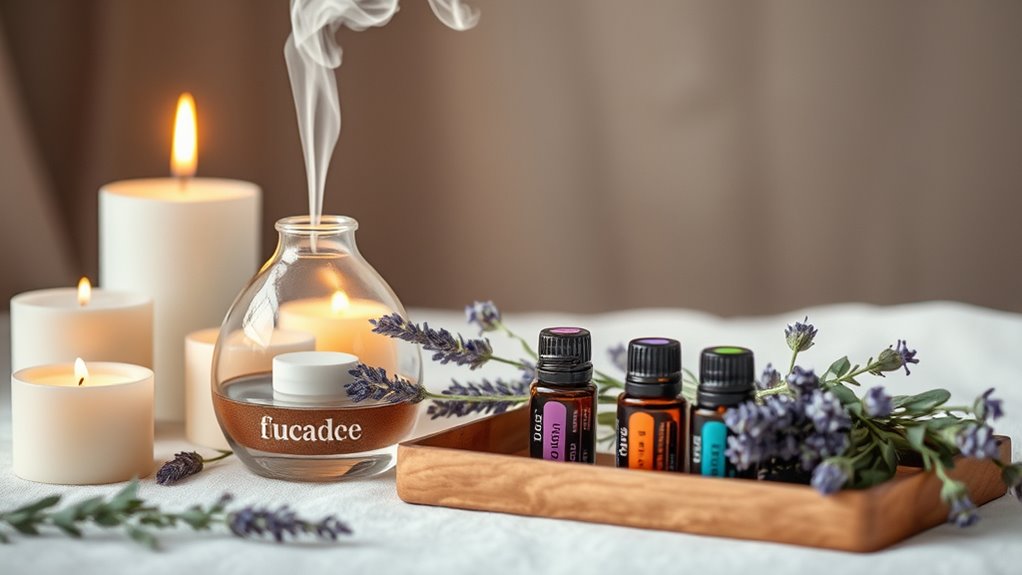Mindfulness & Well‑Being
Nature Soundscapes: Using Audio to Reduce Stress
Lulling nature soundscapes can significantly reduce stress and enhance mental clarity, but discovering how they work reveals even greater benefits.

Listening to nature soundscapes is a simple, effective way to lower stress and improve mental clarity. These calming sounds, like bird calls, rustling leaves, and gentle winds, help you relax by transporting you to peaceful outdoor environments. They can block out distracting noise and encourage slow breathing, which reduces tension. If you want to discover how these audio environments can boost your well-being, there’s more to explore.
Key Takeaways
- Nature soundscapes promote relaxation by mimicking natural environments, helping to shift focus from stress to the present moment.
- Listening to bird calls, rustling leaves, and wind sounds can lower cortisol levels and reduce mental tension.
- Regular exposure to nature audio enhances sleep quality by signaling relaxation and blocking disruptive noises.
- Nature sounds encourage slow breathing and mindfulness, supporting stress management and overall mental health.
- Accessible through apps and devices, these soundscapes offer an easy, natural method for daily stress relief and relaxation.

Nature soundscapes offer a soothing escape from the noise of everyday life, immersing you in the natural symphony of the outdoors. When you listen to these sounds, you’re transported to tranquil environments where stress begins to melt away. One of the most enchanting elements of nature soundscapes is the gentle chorus of bird calls. These melodies, varying from cheerful chirps to melodious trills, create a calming backdrop that instantly relaxes your mind. As you tune in, you might imagine yourself wandering through a lush, green forest, where every bird adds a layer to the forest ambiance. The combination of bird calls and the rustling leaves forms a harmonious soundscape that reduces tension and promotes mental clarity.
Immerse yourself in tranquil nature soundscapes filled with cheerful bird calls and rustling leaves that calm the mind.
The forest ambiance is particularly effective in calming your nerves. The subtle sounds of wind whispering through trees, combined with the distant calls of birds, create a peaceful atmosphere that can help reset your mood. When you focus on these sounds, your brain shifts from stressful thoughts to the present moment, grounding your mind in the serenity of nature. This auditory experience not only distracts you from anxiety but also encourages slow, deep breathing, which further lowers your stress levels. Whether you’re at home, in the office, or on a walk, playing recordings of forest ambiance can serve as a natural stress reliever.
Listening to nature soundscapes with bird calls and forest ambiance can also improve your sleep quality. As these sounds mimic the natural environment, they signal your brain to relax and unwind, making it easier to fall asleep. The rhythmic patterns and gentle melodies act as a form of white noise, blocking out distracting sounds and creating a peaceful setting for rest. Over time, regularly immersing yourself in these soundscapes can enhance your overall sense of well-being, helping you manage stress more effectively.
You don’t need to be in a forest to enjoy these benefits. Many apps and online platforms offer high-quality recordings of bird calls and forest ambiance. With a pair of headphones or speakers, you can easily incorporate these calming sounds into your daily routine. Whether you need a moment of respite during a hectic day or a way to unwind before bed, nature soundscapes provide a simple, accessible method to reduce stress, reconnect with the natural world, and restore your sense of calm.
Additionally, these soundscapes can enhance mental health by fostering relaxation and mindfulness during stressful times.
Frequently Asked Questions
How Do Individual Preferences Influence the Effectiveness of Nature Sounds?
Your personal preferences greatly influence how effective nature sounds are for stress reduction. When you choose sounds that resonate with you, like rainforest or ocean waves, they create a calming effect. Sound customization allows you to tailor the audio to your liking, making it easier to relax. If you select sounds you enjoy, you’re more likely to experience the full benefits of stress relief, enhancing your overall well-being.
Can Nature Soundscapes Replace Traditional Stress Management Techniques?
Did you know that 65% of people report feeling calmer with nature soundscapes? While they can be a great addition to your stress reduction techniques, they shouldn’t replace traditional methods like exercise or therapy. Nature soundscapes provide quick relief and enhance relaxation, but for lasting stress management, you should combine them with proven techniques. Relying solely on soundscapes might not address deeper stress issues effectively.
Are There Specific Types of Nature Sounds More Effective for Certain Stress Levels?
You’ll find that bird chirping is especially effective if you’re mildly stressed, as it promotes calmness and alertness. Flowing water works best when stress levels are high, helping you relax and reset quickly. Depending on your mood, switching between these sounds can optimize stress relief. Try incorporating both into your routine for a tailored experience, and notice how each type influences your relaxation and overall well-being.
How Long Should One Listen to Nature Sounds for Optimal Stress Relief?
Imagine a gentle river carving through your worries; that’s what listening to nature sounds can do. For ideal exposure, aim for 20 to 30 minutes, allowing your mind to drift into calm waters. Listening duration matters—too short might leave stress lingering, while too long can lead to diminishing returns. Find your rhythm, and let these sounds be the steady current guiding you to tranquility.
Do Nature Soundscapes Have Any Long-Term Benefits on Mental Health?
Yes, nature soundscapes can positively impact your long-term mental health by promoting sustained relaxation. Regularly immersing yourself in these sounds helps reduce chronic stress, improve mood, and boost overall well-being. Over time, this practice can strengthen your resilience to mental health challenges. Incorporating nature sounds into your routine creates a calming environment, supporting ongoing mental health benefits and helping you maintain a balanced, relaxed state of mind.
Conclusion
Listening to nature soundscapes can considerably lower your stress levels and improve your overall well-being. In fact, studies show that just 20 minutes of exposure to natural sounds can reduce cortisol, the stress hormone, by up to 30%. So next time you’re feeling overwhelmed, try immersing yourself in the calming sounds of nature. It’s a simple, powerful way to recharge and find peace amidst your busy day. Your mind and body will thank you for it.
Mindfulness & Well‑Being
Aromatherapy & Essential Oils: Evidence for Well‑Being
Unlock the potential of aromatherapy and essential oils to enhance your well-being—discover how these natural scents may transform your health journey.

Aromatherapy and essential oils have scientific backing showing they can boost your well-being by promoting relaxation, reducing stress, and improving your mood. Studies suggest that certain oils like lavender may lower cortisol levels and ease anxiety, making them a natural complement to your health routine. When used safely and consistently, these scents can support your emotional and physical health. If you want to discover how specific oils may benefit you, keep exploring the options available.
Key Takeaways
- Scientific studies suggest essential oils like lavender may reduce cortisol levels and alleviate anxiety.
- Aromatherapy can promote relaxation, improve sleep quality, and support emotional well-being.
- Evidence indicates certain oils help boost mood and reduce stress when used properly.
- Proper dilution and safety guidelines are essential for effective and safe aromatherapy practice.
- Aromatherapy is a complementary approach that may enhance overall health but should not replace medical treatment.

Aromatherapy and essential oils have gained popularity as natural ways to promote well-being and balance. When you explore scent therapy, you’re tapping into a centuries-old practice that aims to support holistic health. Instead of relying solely on medication or conventional treatments, scent therapy involves using fragrant plant extracts to influence your physical, emotional, and mental state. This approach recognizes that health isn’t just about addressing symptoms but fostering overall harmony within your body and mind.
Discover the holistic power of scent therapy using natural essential oils to support your well-being and harmony.
As you incorporate essential oils into your routine, you’re engaging in a form of holistic health. These oils aren’t just about smelling nice; they’re believed to contain therapeutic properties that can help alleviate stress, improve sleep, boost mood, and even support immune function. For example, lavender is renowned for its calming effects, making it a popular choice for reducing anxiety and promoting restful sleep. Eucalyptus, on the other hand, is often used to clear respiratory pathways and boost energy levels. The key is understanding that scent therapy isn’t a one-size-fits-all solution—different oils can target specific needs, and their effects may vary from person to person.
You can use essential oils in various ways to support your well-being. Diffusing them in your living space allows the aroma to fill the air, creating a calming or invigorating environment. You might also add a few drops to a warm bath or create a personalized massage oil. When applied topically, it’s important to dilute essential oils with a carrier oil to prevent irritation. Regardless of the method, the goal is to harness the natural scent properties of these oils to influence your mood and physiological responses.
Scientific evidence supports some benefits of scent therapy, though it’s not a cure-all. Studies suggest that certain essential oils can reduce cortisol levels, ease symptoms of depression, or promote relaxation. Additionally, understanding the safe use of essential oils, including proper dilution guidelines, ensures a positive experience and minimizes risks. However, the effects are often subtle and can depend on individual preferences and sensitivities. It’s essential to approach aromatherapy as a complementary practice rather than a replacement for medical treatment. As you experiment with different oils, pay attention to how each one makes you feel and adjust accordingly.
In the end, incorporating essential oils into your daily routine can be a meaningful way to support your holistic health. By embracing scent therapy, you’re engaging your senses to enhance your emotional, mental, and physical well-being naturally. Always remember to use high-quality oils and consult with healthcare professionals if you have underlying health conditions or are pregnant. With mindful use, aromatherapy can become a gentle, effective tool for maintaining balance and promoting overall wellness.
Frequently Asked Questions
Can Aromatherapy Replace Conventional Medical Treatments?
Aromatherapy can’t replace conventional medical treatments, but it can serve as a helpful complementary therapy. You might find it enhances your overall well-being and supports holistic approaches to health. While it offers relaxation and stress relief, always consult your healthcare provider before relying solely on aromatherapy for serious conditions. Incorporating essential oils thoughtfully can contribute to your wellness plan without substituting proven medical care.
Are There Any Safety Concerns With Essential Oil Use?
Sure, using essential oils is perfectly safe—if you follow dilution guidelines and watch for skin sensitivity. Ignoring these precautions might turn your relaxing lavender into a fiery disaster or a rash-inducing nightmare. Always dilute oils properly and do a patch test to avoid allergic reactions. Remember, even natural substances can cause harm if misused, so stay cautious and informed to enjoy aromatherapy safely!
How Do I Choose the Right Essential Oil for Me?
You should choose an essential oil based on your personal preferences and scent selection. Start by exploring different fragrances to see which ones evoke positive feelings or relaxation. Consider your needs, like calming or energizing effects, and pick oils known for those benefits. Always test a small amount first to guarantee you don’t have sensitivities. Trust your instincts and select scents that resonate with you for a more enjoyable experience.
Can Aromatherapy Help With Specific Mental Health Issues?
Did you know that over 60% of people report using aromatherapy to manage stress? Yes, it can help with specific mental health issues by enhancing mindfulness benefits and supporting emotional regulation. Essential oils like lavender or chamomile may reduce anxiety and promote relaxation. While not a substitute for professional help, incorporating aromatherapy into your routine can complement other mental health strategies effectively.
What Is the Best Way to Store Essential Oils?
To maximize essential oil longevity, store them in dark glass bottles away from direct sunlight and heat. Keep caps tightly sealed to prevent oxidation and evaporation. Store oils in a cool, dry place, like a drawer or cupboard, to maintain their potency. Follow these storage tips, and your essential oils will stay fresh longer, ensuring you get the most benefit from their therapeutic properties whenever you use them.
Conclusion
So, next time you’re drowning in stress, just spritz some lavender, breathe in, and pretend it’s a miracle cure. Who needs science when you’ve got a scented bottle promising paradise? Maybe those essential oils are your new best friend—unless you’d rather face reality with a pinch of skepticism. Either way, remember: a whiff of wellness might just be your ticket to bliss… or at least a good sniff before the chaos resumes.
Mindfulness & Well‑Being
Sleep Optimization: Tools & Habits for Restorative Rest
Discover essential tools and habits for sleep optimization that can transform your rest—continue reading to unlock your best sleep yet.

To optimize your sleep, focus on establishing a consistent schedule, going to bed and waking up at the same times daily. Create a calming pre-sleep routine, limit screen time and artificial light in the evening, and make sure your bedroom is cool, dark, and quiet. Increase natural light exposure during the day to reinforce your body’s internal clock. Incorporating these tools and habits can lead to more restorative sleep, naturally improving your overall well-being—if you keep exploring, you’ll discover more effective strategies.
Key Takeaways
- Establish a consistent sleep schedule and routine to reinforce your circadian rhythm.
- Use tools like blackout curtains and white noise machines to create an optimal sleep environment.
- Increase natural light exposure during the day and limit blue light in the evening to support melatonin production.
- Engage in relaxing pre-sleep activities and avoid stimulating screens or heavy meals before bed.
- Prioritize 7-9 hours of quality sleep each night to promote restorative rest and overall health.

Have you ever wondered why some people wake up feeling refreshed while others struggle through the day? It often comes down to two key factors: sleep hygiene and your circadian rhythm. Sleep hygiene refers to the habits and environment that support quality sleep, while your circadian rhythm is your body’s internal clock that regulates sleep-wake cycles. When these elements are aligned and well-maintained, you’re more likely to wake up feeling energized and ready to tackle the day.
Good sleep hygiene starts with establishing a consistent sleep schedule. Going to bed and waking up at the same time every day helps train your circadian rhythm, so your body knows when to wind down and when to wake up. Avoid caffeine, nicotine, and heavy meals too close to bedtime, as these can interfere with falling asleep. Instead, create a calming pre-sleep routine—dim the lights, turn off screens, and engage in relaxing activities like reading or gentle stretches. Your environment also matters; a cool, dark, and quiet bedroom fosters better sleep by minimizing disruptions and signaling to your body that it’s time to rest.
Your circadian rhythm influences your sleep quality because it governs the release of hormones like melatonin, which promotes sleep, and cortisol, which helps you wake up. When your rhythm is disrupted—say, by irregular sleep times, shift work, or jet lag—it throws off your sleep cycle, leading to insomnia or daytime fatigue. To keep your circadian rhythm in sync, expose yourself to natural light during the day, especially in the morning. This helps reinforce your internal clock and improves the quality of your rest. Conversely, limit exposure to artificial light, particularly blue light from screens, in the evening, as it suppresses melatonin production and makes falling asleep harder. Supporting your sleep-wake cycle with regular habits can enhance overall sleep quality and health.
Incorporating habits that support your circadian rhythm and sleep hygiene can make a significant difference. Aim for at least seven to nine hours of sleep per night. Stick to your sleep schedule even on weekends to maintain consistency. Consider using blackout curtains and white noise machines if your environment isn’t ideal. Also, wind down with relaxing activities rather than stimulating ones right before bed. These small changes signal to your body that it’s time to rest, helping your internal clock stay on track.
Frequently Asked Questions
How Does Sleep Quality Affect Mental Health?
Good sleep quality directly impacts your mental health by reducing stress and improving mood. When you prioritize your sleep environment—keeping it dark, cool, and quiet—you create ideal conditions for rest. Dream journaling helps you process emotions and identify patterns affecting your mental well-being. By consistently improving your sleep habits, you support mental clarity, emotional resilience, and overall psychological health, leading to a happier, more balanced life.
Can Diet Influence Sleep Patterns Significantly?
Yes, diet can considerably influence your sleep patterns. When you focus on nutrition and rest, you’ll notice that what you eat impacts your sleep quality. Foods rich in magnesium, tryptophan, and melatonin can promote better rest, while caffeine and heavy meals close to bedtime can disrupt it. By making mindful choices about your diet and sleep, you support restorative sleep and overall well-being.
What Role Does Exercise Play in Sleep Improvement?
Exercise energizes and eases your mind, promoting peaceful sleep. Timing matters—working out too late can interfere with your rest, while morning or early evening activity maximizes physical activity benefits. Regular exercise reduces restlessness, relieves stress, and enhances sleep quality. By incorporating consistent physical activity, you set a stronger, steadier sleep schedule. You’ll find that a well-timed workout works wonders, weaving wellness into your nightly rest and waking up refreshed.
Are Natural Supplements Effective for Sleep Enhancement?
Natural supplements like melatonin and herbal remedies can help improve your sleep, especially if you struggle with falling asleep or staying asleep. Melatonin supplements regulate your sleep-wake cycle, making it easier to drift off. Herbal remedies like valerian root or chamomile promote relaxation and reduce anxiety. While they can be effective, it’s best to utilize them responsibly and consult a healthcare professional to ensure they suit your needs and don’t interfere with medications.
How Long Does It Take to Notice Sleep Improvements?
Most people notice sleep improvements within one to two weeks of tracking sleep and maintaining consistency. Research shows that establishing a regular sleep schedule can boost sleep quality markedly in just a few days. By using sleep tracking tools, you’ll see patterns and adjust habits accordingly. Stay consistent with your bedtime and wake time, and you’ll likely experience better rest faster than you expect.
Conclusion
Now that you know the key tools and habits for better sleep, imagine what’s possible with truly restorative rest. Will you discover the secrets to waking up refreshed every day? The choices you make tonight could change everything—but only if you take action. Don’t wait—your best sleep is just a habit away. Are you ready to discover what’s next on your journey to perfect rest? The answer awaits, and it starts with you.
Mindfulness & Well‑Being
Resilience Training at Home: Adapt Navy SEAL Techniques for Everyday Life
Achieve mental toughness at home by adapting Navy SEAL techniques, unlocking the secret to overcoming life’s daily challenges effectively.

To build resilience at home using Navy SEAL techniques, start by practicing mental discipline through visualization of successful outcomes in challenging situations. Use controlled breathing, like box breathing, to stay calm under pressure. Establish routines that promote mental toughness, such as quick stress-relief exercises and dedicated relaxation spaces. Focus on consistency and mindset shifts from impulsive reactions to problem-solving. Keep exploring these methods to strengthen your resilience and face daily obstacles with greater confidence.
Key Takeaways
- Incorporate Navy SEAL mental discipline practices like visualization and controlled breathing to enhance daily resilience.
- Develop routines that include stress management techniques such as mindfulness and quick physical exercises for automaticity.
- Create dedicated calm spaces at home to foster a supportive environment for mental toughness training.
- Set small, achievable goals daily to build confidence and reinforce problem-solving mindset under stress.
- Use disciplined routines and environmental cues to maintain consistency and strengthen resilience muscles over time.

Building resilience at home is a practical way to strengthen your mental and emotional well-being, especially during challenging times. When you develop resilience, you learn to bounce back from setbacks and maintain your focus amid adversity. One key aspect of resilience is mental toughness—a trait that helps you stay calm, confident, and centered, even when life throws obstacles your way. Cultivating mental toughness at home involves creating routines and habits that reinforce your ability to handle stress effectively. It’s about shifting your mindset from reacting impulsively to approaching difficulties with a composed, problem-solving attitude. You can start by setting small, achievable goals each day that push you slightly out of your comfort zone, gradually building your capacity to cope with larger challenges.
Building resilience at home by developing mental toughness and setting small, achievable goals.
Stress management is another essential element in resilience training. When you’re able to manage stress, you prevent it from overwhelming you, which helps you maintain clarity and emotional stability. Techniques like deep breathing, mindfulness, or even short physical exercises can serve as quick reset buttons during tense moments. Incorporating these practices into your daily routine makes them second nature, allowing you to stay composed when facing unexpected problems. Resilience isn’t about avoiding stress but learning how to manage it constructively. At home, you can create a calming environment—dedicated spaces for relaxation, regular breaks, or a consistent sleep schedule—that supports your stress management efforts. This environment fosters mental toughness because it trains you to remain resilient in the face of daily pressures. Additionally, understanding retirement tax laws can help you plan your financial resilience more effectively, ensuring your financial stability remains intact regardless of market fluctuations.
Furthermore, adopting Navy SEAL techniques at home can considerably boost your mental toughness and stress management skills. SEAL training emphasizes mental discipline, visualization, and controlled breathing—methods you can easily adapt for everyday life. For instance, practicing visualization helps you prepare mentally for stressful situations by imagining successful outcomes. Controlled breathing exercises, like box breathing, calm your nervous system, making it easier to stay composed during high-stress moments. By integrating these techniques into your routine, you strengthen your resilience muscle, making it easier to handle setbacks without becoming overwhelmed or discouraged.
Ultimately, resilience training at home empowers you to face life’s challenges head-on. It’s about cultivating mental toughness and mastering stress management strategies that keep you grounded, focused, and adaptable. As you consistently practice these techniques, you’ll notice increased confidence and emotional stability, no matter what difficulties arise. Building resilience isn’t an overnight process, but with intentional effort, you’ll develop a resilient mindset that prepares you to navigate both everyday struggles and unexpected crises with resilience and strength.
Frequently Asked Questions
Can Civilians Fully Replicate Navy SEAL Resilience Techniques?
You can’t fully replicate Navy SEAL resilience techniques as a civilian, but you can develop mental toughness and physical endurance by adapting their methods. Focus on disciplined routines, stress management, and pushing your limits gradually. While you won’t experience their elite training environment, practicing these principles at home helps build resilience, confidence, and endurance for everyday challenges. Consistency and dedication are key to making meaningful progress.
How Often Should I Practice Resilience Training at Home?
You should practice resilience training at home at least 3 to 4 times a week to build consistency and see real progress. Regular, dedicated sessions help reinforce mental toughness and adaptability, making resilience a natural part of your daily life. Keep a consistent schedule, stay committed, and gradually increase intensity to maximize benefits. Remember, the key is frequency and consistency to develop lasting resilience skills.
Are There Specific Age Restrictions for Resilience Exercises?
Surprisingly, resilience exercises have no strict age limitations, so even youth participation is encouraged. You might think these Navy SEAL techniques are only for adults, but kids and teens can benefit too. Just tailor the activities to suit their age and maturity. By doing so, you’ll help build mental toughness early on, proving resilience isn’t just for grown-ups—it’s a skill anyone can develop, no matter their age.
What Equipment or Resources Are Needed for At-Home Training?
You only need basic equipment essentials for at-home resilience training, making resource accessibility simple. Items like a sturdy chair, a timer or stopwatch, and comfortable workout gear are enough to get started. You can also use household items, such as water bottles or a towel, to enhance exercises. Focus on creating a distraction-free space, and guarantee your resources are readily available to maintain consistency and build mental toughness effectively.
How Long Does It Take to See Results From Resilience Training?
You’ll start noticing improvements in mental conditioning and stress management within just a few weeks of consistent resilience training. Studies show that regular practice can boost resilience by up to 25% in as little as four weeks. With dedication, you’ll build mental toughness, better handle stress, and develop a stronger mindset. Keep practicing daily, and you’ll see tangible results that enhance your overall well-being in a relatively short time.
Conclusion
Now, picture yourself standing strong amidst life’s stormy seas, each wave testing your resolve. By adopting Navy SEAL resilience techniques at home, you’re building an unshakable foundation within. When challenges crash over you, remember your inner strength, like a lighthouse guiding you through the darkness. With every breath, you become more adaptable, more resilient. Embrace these methods, and watch yourself rise above, shining brighter than ever before, ready to face whatever comes your way.
-

 Wish Notes1 year ago
Wish Notes1 year agoBest Caption to Wish Myself a Happy Birthday That Everyone Will Like!
-

 Wish Notes1 year ago
Wish Notes1 year agoThe Best Birthday Wishes to Make Your Uncle's Day Bright!
-

 Wish Notes1 year ago
Wish Notes1 year agoThe Sweetest Happy Birthday Wishes for Your Wife!
-

 Wish Notes1 year ago
Wish Notes1 year agoThe Best Happy Birthday Wish for Your Brother That Will Make Him Smile!
-

 Wish Notes1 year ago
Wish Notes1 year agoHeartwarming Birthday Messages for Mom in Spanish
-

 Wish Notes1 year ago
Wish Notes1 year agoThe Best Happy Birthday Wishes for Your Husband That Will Make His Day!
-

 Wish Notes1 year ago
Wish Notes1 year agoThe Ultimate Birthday Wishes to Celebrate Yourself!
-

 Wish Notes1 year ago
Wish Notes1 year agoThe Most Heartfelt Good Night Wishes Ever!






















